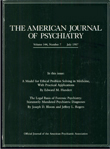Abortion: Facts and Feelings
All of us have personal feelings about abortion. These feelings are colored by our personal beliefs, political agenda, religious upbringing, and life-long experience. As psychiatrists, we are not often confronted with patients wrestling with the decision regarding whether to have an abortion. On the other hand, we often treat female patients who have had an abortion and feel upset, guilty, or uneasy about the choice they made. The decision to have an abortion is not an easy one, and the procedure itself leaves patients with a host of unresolved issues.
Dr. Stotland has written a comprehensive book based on a careful review of medical, psychological, and other relevant literature. The book was designed to include and respect a wide variety of philosophical and religious approaches to pregnancy and termination of pregnancy. Dr. Stotland feels strongly that women have the right to make their own individual, informed, and supported reproductive choices. To that end, she has authored a book designed for women and their significant others, physicians, parents, relatives, friends, and professional counselors. Each of the chapters has been thoroughly researched; all are written in clear, concise language suitable for a layperson or a professional.
I was particularly impressed by the chapter titled, “For the Professional Counselor.” Dr. Stotland notes that the professional counselor may be a religious leader, marriage or family counselor, school or guidance counselor, employee assistance program professional, psychologist, social worker, or psychiatrist working in an abortion clinic or another setting. She recognizes that each of these professionals has a different role and a different responsibility. She notes that the counselor not only provides counseling before the decision but also gets feedback from women after an abortion, such as, “Were the procedures as they were led to expect? Were the staff competent? Supportive? Do they have suggestions for improvements in the services provided by the clinic or the counselor?”
Dr. Stotland emphasizes that counselors have to review their own backgrounds, their religious and philosophical beliefs, and their values and experiences concerning pregnancy and abortion. She reminds the professional that prejudice for or against a particular course of action must be made clear to the patient in advance and that professional attitudes must be clarified so that those attitudes do not unconsciously contaminate counseling work. She recognizes the enormous challenge involved in sifting out one’s own personal beliefs in order to provide an objective situation for the patient.
Dr. Stotland also points out the importance of sensitivity to cultural considerations of particular patients. She does not attempt to discuss each particular cultural consideration, so this section of the book is pretty general rather than specific to a particular culture. She really emphasizes the importance of avoiding unwarranted options based on the counselor’s own background and personal experience.
In a section about the young client, she emphasizes that adolescents may fantasize that their parents will react more strongly and negatively than parents actually do and that it is important to encourage the adolescent seeking an abortion to discuss her own situation with her parents, offering to meet with the adolescent’s parents and help involve them in the discussion of options.
Finally, Dr. Stotland offers some very practical advice about the particular questions that women clients want to know. It is clear that she has had extensive experience helping patients make this painful decision because the questions have profound implications but on the surface seem so practical that the counselor might ignore this area while simply focusing on the decision. For example, patients want to know if it is likely that there will be people demonstrating outside the clinic and, if so, whether escorts are available to accompany patients; they also want to know how much time each step of the process will take.
The book concludes with a resource directory. This section on resources may be the most valuable section for the psychiatrist in that it provides information about support organizations as well as organizations providing financial assistance, legal information, data on racial and ethnic groups, and general information.
The apparent simplicity of this well-written book belies the amount of research, experience, and thought that has gone into its organization and the choice of language used in explaining all ethical, legal, religious, and medical viewpoints. Dr. Stotland has provided a concise, valuable guide to patients and clients making intensely personal decisions about abortion and a guide to those who are in the role of a support system, helper, or partner to a pregnant woman deciding what to do about an unplanned pregnancy.



